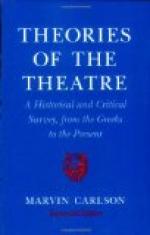The greatest revolution of modern times in stage conventions owes its origin directly to the invention of the electric light. Now that it is possible to make every corner of the stage clearly visible from all parts of the house, it is no longer necessary for an actor to hold the centre of the scene. The introduction of electric lights abolished the necessity of the “apron” stage and made possible the picture-frame proscenium; and the removal of the “apron” struck the death-blow to the Drama of Conversation and led directly to the Drama of Illusion. As soon as the picture-frame proscenium was adopted, the audience demanded a picture to be placed within the frame. The stage became essentially pictorial, and began to be used to represent faithfully the actual facts of life. Now for the first time was realised the graphic value of the curtain-fall. It became customary to ring the curtain down upon a picture that summed up in itself the entire dramatic accomplishment of the scene, instead of terminating an act with a general exodus of the performers or with a semicircle of bows.
The most extraordinary advances in natural stage-settings have been made within the memory of the present generation of theatre-goers. Sunsets and starlit skies, moonlight rippling over moving waves, fires that really burn, windows of actual glass, fountains plashing with real water,—all of the naturalistic devices of the latter-day Drama of Illusion have been developed in the last few decades.
III
Acting in Elizabethan days was a presentative, rather than a representative, art. The actor was always an actor, and absorbed his part in himself rather than submerging himself in his part. Magnificence rather than appropriateness of costume was desired by the platform actor of the Drama of Rhetoric. He wished all eyes to be directed to himself, and never desired to be considered merely as a component part of a great stage picture. Actors at that time were often robustious, periwig-pated fellows who sawed the air with their hands and tore a passion to tatters.




